RSN: Ukraine's Much-Heralded Counteroffensive Could Work. The Defeatists Won't Admit It.
Live on the homepage now!
Reader Supported News
Those who thought Russia would trounce Kyiv don't let reality get in the way of their convictions.
Yet the doubters — many of whom confidently predicted at the start of the war that Ukraine couldn’t possibly resist a Russian invasion and that Western military assistance to Ukraine wouldn’t make a difference — still can’t let evidence to the contrary get in the way of their convictions.
When Russian forces finally managed to seize two important eastern cities by early July after months of struggling in their war with Ukraine, the defeatists — from think tank analysts and academics to former foreign policy hands to allegedly anti-imperialist leftists — again insisted that Ukraine had no hope of prevailing against Russia’s superior might. In advance of the new operation this week, the doubt continued. A typical argument is that it would take a “miracle” for Ukraine to succeed.
Broadly, this cohort wants Washington to withhold aid to pressure Kyiv to sue for peace and concede Ukrainian land seized by Russia rather than continue to resist. Give Russian President Vladimir Putin an excuse to declare victory, they claim, and he’ll take the opportunity to negotiate a peace agreement and bow out with his pride intact.
Ukraine is inclined to do otherwise. Mykhailo Podolyak, an adviser to Ukrainian President Volodymyr Zelenskyy, tweeted Monday: “The only possible option for negotiations with Russia is being conducted by a special Ukrainian delegation in the southern and other directions of the frontline.”
Moscow, too, is sending no signals that it’s ready to discuss a diplomatic resolution. The recent Russian government statement that it still seeks to overthrow Ukraine’s government, combined with senior officials’ speaking openly of destroying the concept of a Ukrainian nation (even though both goals now seem unachievable), should dispel wishful thinking that Putin is in a compromising mood.
In fact, Russia’s own military appears more pessimistic about its capabilities than the Ukraine defeatists. Russian operations in eastern Ukraine have decreased markedly in energy since July as Moscow has shifted forces to southern Ukraine in expectation of a Kherson counteroffensive. That’s because both sides can see Russia’s vulnerability in this sector and how that gives Ukraine a credible shot at liberating Kherson.
The southern port city is politically and strategically important. Symbolically it matters because its residents have actively resisted Russia’s occupation through civil disobedience and armed resistance, unlike many cities in the east that Ukrainian civilians largely evacuated when Russia captured them. In return, human rights groups have observed that Russian troops have kidnapped, tortured or killed many of those resisting, and Moscow is expected to conduct a “referendum” aimed at creating a separatist republic in the region.
Militarily, the city and its bridges serve as a Russian toehold on the southwest bank of the Dnieper River, which cuts Ukraine in two. Russian control of Kherson allows the Kremlin to continue to use the city as a base to try to capture the neighboring ports of Odesa and Mykolaiv, thereby crippling Ukraine’s export-based economy. Conversely, liberating Kherson is probably a prerequisite for Ukraine to recapture several other cities.
Kyiv made some earlier efforts that didn’t bear much fruit in Kherson, but the tables turned by the end of July. Over the last month, Russian ammunition depots began evaporating in massive explosions in precision attacks by rocket artillery systems supplied by the U.S., causing Russian shelling to decline precipitously, according to Ukrainian commanders. Ukraine also picked off Russian air defense systems and killed multiple high-ranking commanders meeting at headquarters, according to Ukrainian reports.
Then, this month, Ukrainian forces wiped out numerous Russian warplanes on the ground and blew up depots in adjacent Crimea using still-undisclosed means. This came as a massive shock, as Crimea — seized by Russian troops in 2014 — was considered so firmly under Russian control that it has still been frequented by Russian vacationers this summer.
At the same time, Russia’s foothold on the side of a river mostly controlled by Ukraine is inherently hard to defend, because supplies and reinforcements are bottlenecked through a limited number of bridges and ferries. The U.S.-supplied HIMARS artillery has also enabled Ukraine to precisely target these bridges, heavily damaging them.
To be sure, no one should take for granted that these strategies guarantee Ukrainian victory. Assaulting prepared defensive positions is usually difficult and costly, and Russia has heavily fortified the outskirts of Kherson. Ukrainian troops must undertake large-scale coordination of infantry, tanks, artillery and airpower to succeed — a combined arms operation that Ukraine’s army has little experience performing at such scale. Russia itself has failed disastrously at executing this tricky type of operation.
And Ukraine has to fight smartly, because it can’t generate the numerical superiority that generally secures a win through brute force (simplistically calculated as a 3-to-1 ratio of attackers to defenders), especially factoring in Russian reserves now deployed nearby. Pulling off a victory likely requires Ukraine to have husbanded a large, fresh force that has received more extensive training than usual, perhaps including drills with NATO instructors elsewhere in Europe. And Ukraine’s counteroffensive may, at least initially, take the form of several short hops rather than a sustained drive so as not to overtax its forces.
So much is uncertain in war. However, this month we have clearly reached the point where Russia’s military can no longer “continue their steady advance,” as Moscow’s partisans have often bragged — and it is bracing for Ukraine’s counterpunch.
Accordingly, the West should continue its support of Ukraine so it can take back territories occupied by Russia rather than follow the counsel of pessimists. Some have track records of pro-Putin and anti-Ukrainian rhetoric or openly flaunt their utter lack of concern for anything transpiring outside America’s borders or are so-called anti-imperialists who appear ready to sing the praises of an invasion if it’s opposed by Washington. Others rightly deplore the horrible violence of this war but are too quick to reward indefensible aggression in hope of a quick resolution.
U.S. and European weapons have already helped bring a halt to Russia’s slow advance in the east and created the potential for Ukraine’s southern counteroffensive. If that aid can be sustained — and undeniably, there are challenges and costs involved — it will make Russia’s invasion less and less sustainable. That’s ultimately what will gravely weaken the Kremlin’s illegal occupation of Ukrainian cities and its impetus to take what it wants through force, something that’s a threat not only to Ukraine but also to the U.S. and its allies.
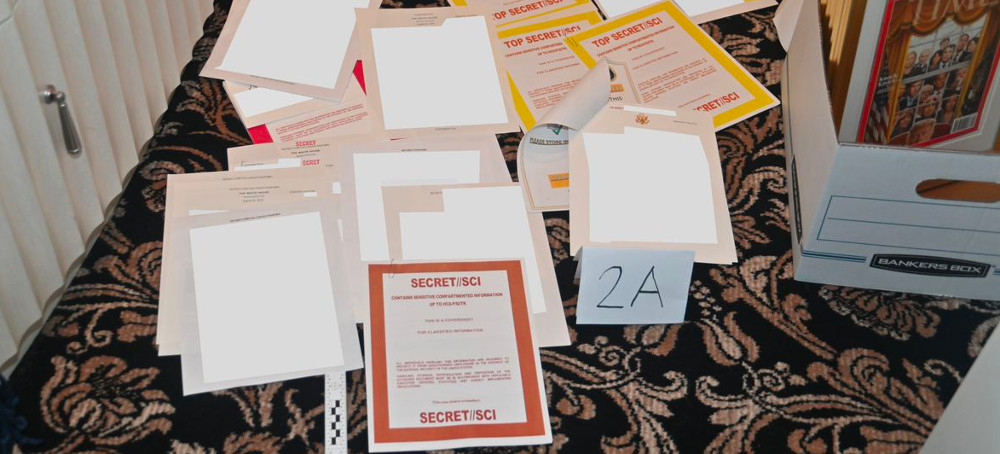 A photo of classified documents on the floor at Mar-a-Lago was included in a 36-page filing from the Department of Justice. (photo: Department of Justice)
A photo of classified documents on the floor at Mar-a-Lago was included in a 36-page filing from the Department of Justice. (photo: Department of Justice)
Including that he may have obstructed justice by hiding classified documents at Mar-a-Lago.
The image was attached to a 36-page filing from the Department of Justice in the ongoing court battle by Trump to have a special master review the documents seized by federal agents when they searched Mar-a-Lago, Trump’s private Florida club and residence, in August. And it’s by no means the most damning claim from the overnight court filing, which you can read below.
- In the filing, the DOJ asserts that Trump was likely taking efforts to obstruct justice: “The government also developed evidence that government records were likely concealed and removed from the Storage Room and that efforts were likely taken to obstruct the government’s investigation.”
- Trump’s lawyers claimed to the DOJ there were no other classified documents at Mar-a-Lago in June. After handing over what they claimed were the remaining classified documents in a sealed legal envelope, a Trump lawyer “represented that there were no other records stored in any private office space or other location at the Premises and that all available boxes were searched.” That envelope contained “38 unique documents bearing classification markings including . . . 17 documents marked as TOP SECRET.”
- The August search warrant at Mar-a-Lago produced “over a hundred classified records including information classified at the highest levels,” including three classified documents that “were located in the desks in the ’45 [Trump’s personal] Office.’”
The filing also contains detailed arguments against the appointment of a special master to review the documents, which Trump has claimed is necessary to review the documents to determine if they contain any privileged material. The DOJ noted a review by a filter team for any privileged information had already been completed. It also pushed back against Trump’s claims of executive privilege to justify holding on to the documents that the National Archives had requested under the Presidential Records Act, noting that there is no precedent for invoking executive privilege “to prohibit the sharing of documents within the Executive Branch.”
Trump’s lawyers are due to file a response on Wednesday, and a hearing is scheduled for Thursday in the matter before Aileen Cannon, a Trump-nominated federal judge in South Florida.
On his personal social media site, Truth Social, Trump said Thursday morning “Terrible the way the FBI, during the Raid of Mar-a-Lago, threw documents haphazardly all over the floor (perhaps pretending it was me that did it!), and then started taking pictures of them for the public to see. Thought they wanted them kept Secret? Lucky I Declassified!”
Trump has claimed that he had somehow automatically declassified any documents at Mar-a-Lago. There is no evidence that he did so, and his lawyers have not made the same claims in court filings.
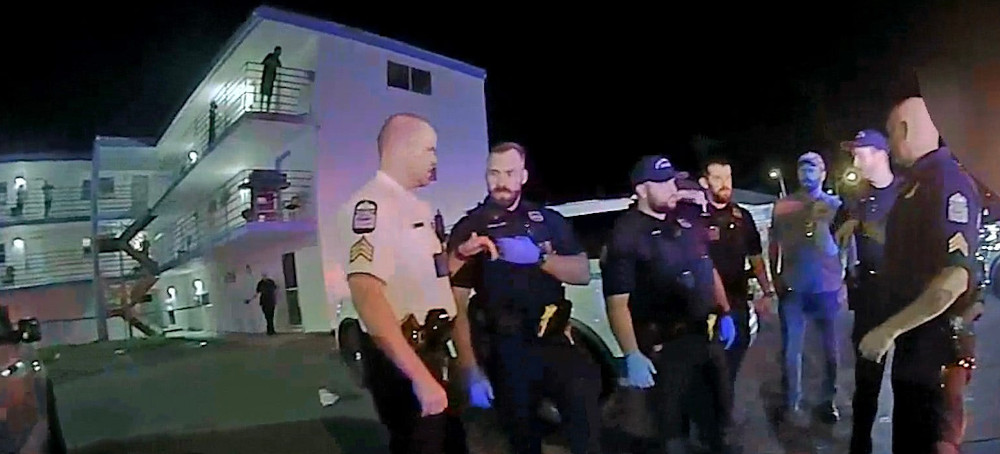 This frame from Columbus Police body camera footage shows police involved in fatal shooting of 20-year-old Donovan Lewis talking outside the three-story building where the incident occurred in the 3200 block of Sullivant Avenue, Columbus, Ohio, August 30, 2022. (photo: Doral Chenoweth/The Columbus Dispatch/Columbus Police)
This frame from Columbus Police body camera footage shows police involved in fatal shooting of 20-year-old Donovan Lewis talking outside the three-story building where the incident occurred in the 3200 block of Sullivant Avenue, Columbus, Ohio, August 30, 2022. (photo: Doral Chenoweth/The Columbus Dispatch/Columbus Police)
Donovan Lewis, 20, was shot while officers were attempting to serve a felony warrant at an apartment in the 3200 block of Sullivant Avenue in Columbus at around 2:30 a.m. on Tuesday, the Columbus Division of Police said.
The officer who shot Lewis was identified by Columbus Police as Ricky Anderson, a 30-year veteran of the department assigned to the canine unit.
At a news conference on Tuesday afternoon, Columbus Police Chief Elaine Bryant said officers had knocked on the door of a second-floor apartment for up to 10 minutes before anyone answered.
Two men who were inside the apartment were taken into custody and officers called a K9 unit to help with a search of the apartment.
The body camera footage shows officers searching the apartment for Lewis, who was wanted on a felony warrant for domestic violence and assault and improperly handling a firearm.
The video shows the dog moving around the kitchen and barking at a bedroom door.
"We're gonna send that dog in," an officer says moments before Anderson moved to hold the door back and opened the bedroom door.
In less than a second, Anderson is seen firing a shot, striking Lewis as he sat up on a bed.
"Hands," one officer is heard repeatedly yelling. He also orders Lewis to "crawl out" multiple times, but he remains on the bed face down.
"Cover me, I'm gonna go in," one officer said a short time later.
"I need cuffs, I'm out of cuffs," an officer in the room can be heard saying on the video. "Hands behind your back, do it now."
An officer is seen lifting Lewis' right arm and attempting to it shift it behind his back while Lewis is heard moaning. "Stop resisting," the officer tells Lewis, who remains face down on the bed.
Officers are later seen carrying Lewis out of the bedroom while his hands are still cuffed behind his back.
Police said officers rendered aid until medics arrived on the scene and transported Lewis to Grant Medical Center in critical condition. He was pronounced dead at the hospital at 3:19 a.m., police said.
Bryant said Anderson fired when Lewis appeared to raise a hand with something in it.
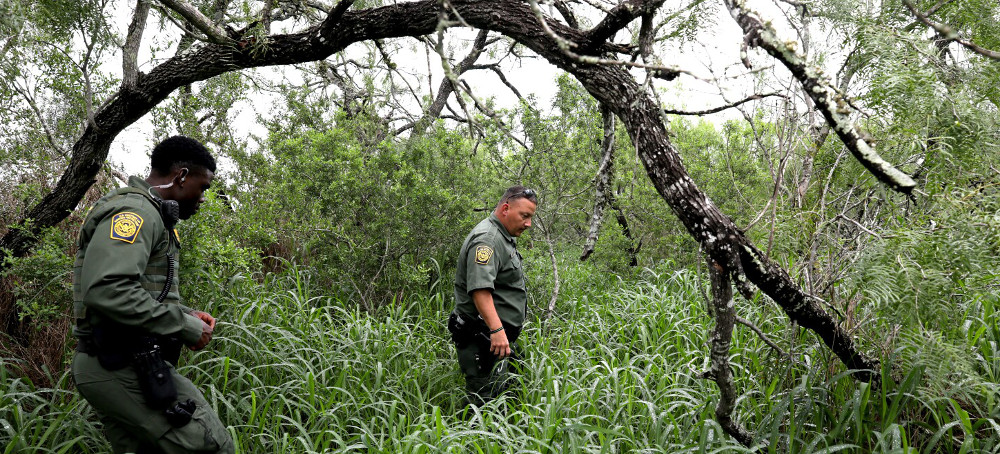 Border patrol agents search for the remains of a deceased migrant on a ranch in Brooks county, Texas. (photo: Gary Coronado/Getty)
Border patrol agents search for the remains of a deceased migrant on a ranch in Brooks county, Texas. (photo: Gary Coronado/Getty)
Immigration policies have forced desperate people to traverse inhospitable landscapes along the US-Mexico border
The intense heat and humidity in this arid scrubland had quickly rotted his flesh to expose much of the skeleton, which had been at the scene for at least a week.
Clearly visible in a graphic image the sheriff’s office provided to the Guardian was the skull, lolling to one side. And both his feet are missing, probably eaten by wild animals.
The man was from Mexico, according to ID documents found. Police explored the possibility it was a lynching, but concluded it was suicide.
“Most of the bodies I encounter are already skeletonised,” said Canales, who runs the South Texas Human Rights Center, a non-profit based in Brooks county, Texas, working to put an end to the avoidable, harsh deaths, and reunite families with the remains of loved ones.
“But this was particularly harrowing. That image will stay with me forever,” he added.
Brooks county covers almost 1,000 square miles of sparse, brush-covered, sandy ranch lands not far from the eastern end of the US-Mexico border and is at the heart of a deadly migration crisis that is seeing desperate people die in record numbers.
So high is the grim toll that the surrounding region, spanning several Texas counties near the Rio Grande, has been called the other Death Valley.
Data bears out that terrible nickname: the Missing Migrants Project, an initiative by the Swiss-based International Organization for Migration (IOM) that tracks migrant deaths and disappearances globally, recorded 715 deaths of people trying to cross the US border from Mexico in 2021 – more than double the figure in 2015, making it the deadliest land crossing in the world.
Of the four US states along the border, Texas has the longest stretch and the highest number of migrant deaths, according to a report by the University of Texas’s Strauss Center. Brooks county, where authorities recovered 119 bodies last year, has had more deaths than any other Texas county over the last three decades.
“We’re struggling to deal with all the bodies,” said Don White, county deputy sheriff. Last year the county was provided with a mobile morgue by the state in response to the grisly human reaping. “I recently had to pick up three fresh ones in a day,” he said.
Outside experts believe that federal immigration policies have exacerbated the tragedy, forcing migrants into ever-more perilous crossings, and leading refugee journeys – fleeing violence, persecution and climate disaster – to an anguished dead end.
Eva Moya, an associate professor at the University of Texas studying the precarity faced by migrants, says the Migrant Protection Protocols (MPP), also known as “Remain in Mexico” – a policy introduced in 2019 under the Trump administration – have resulted in more than 70,000 people being sent back into Mexico to wait for their US court cases, often for extended periods in makeshift camps, where they are often denied basic healthcare and face violence, rape, murder and kidnappings by organised crime groups.
“The risk continues to increase,” says Moya. “Asylum seekers in Mexico are fearing for their lives and smugglers are taking advantage of that. They will do anything to make profit from these people. It’s human trafficking at its max.”
The Biden administration is finally ending the policy, after court battles, but it’s unclear how and when things will change substantially on the ground.
At the same time, Title 42, ostensibly a pandemic-related health measure introduced in 2020, closing border ports of entry and allowing the border patrol to summarily expel migrants without asylum hearings, has contributed to the deaths in Brooks county and beyond, said Alma Maquitico, director of the National Network for Immigrant and Refugee Rights.
“Title 42 has led to a rise in deaths,” she said. “People aren’t crossing at cities any more, but in more faraway, dangerous areas. They are dying in the desert.”
Canales also pointed to the rural, arid expanse.
“This is the real Death Valley,” he said, contrasting it with its scorching desert namesake in California.
“The immigration system has failed. The government wants to blame the cartel but not the policy that is creating this problem. The solution is to offer an ordered asylum pathway. You could fix this tomorrow,” he added.
A spokesperson for US Customs and Border Protection (CBP), which oversees the border patrol’s 20,000 agents working between the land ports of entry, said the death toll was the fault of traffickers.
“Criminal organisations continue to recklessly endanger the lives of individuals they smuggle for their own financial gain with no regard for human life,” they said in a statement. “Despite these inherent dangers, smugglers continue to lie to migrants, claiming the borders are open. The borders are not open, and people should not attempt to make the dangerous journey.”
Although Brooks county is about 70 miles from the US-Mexico border, it has the largest border patrol checkpoint in Texas. Located along US Highway 281, one of the few northbound highways along the hundreds of miles-long south Texas border region, the checkpoint processes an average 10,000 vehicles – traversing the busiest route from Mexico and Central America to the US – each day.
Like other deterrence policies, the checkpoint, instead of reducing the number migrants trying to enter, has driven them into deadly routes, according to deputy sheriff Don White.
People smugglers, often known as coyotes, demand thousands of dollars to help migrants cross the Rio Grande on rafts, usually to McAllen, Texas, where they will hide in dirty, cramped safe houses.
Migrants will then be dropped off 50 miles north on sandy backroads, before being sent on a days-long trek across brutal terrain, where temperatures regularly exceed 100F during the ever-hotter Texas summers and drop below freezing in winter, in order to avoid the checkpoint.
According to Oscar Carrillo, a sheriff in Culberson county, which is also dealing with a surge in bodies, smugglers often send groups of migrants in camouflage gear as well as with backpacks of cannabis, allowing them to reduce the fees owed by delivering the contraband to a contact, if they survive the journey.
In February 2020, Carrillo apprehended a group of more than 50 people en route. “They are given an itinerary like a cruise line,” says Carrillo. “There’s been a huge rise in attempts to cross. But it’s a dangerous place – there are snakes, mountain lions. If they can’t continue, they’ll be left behind.”
For those who make it over the first hurdles in an attempt to reach densely populated cities such as Houston, Dallas and San Antonio, where they can live under the radar of the authorities, the risk is far from over.
In June, 53 immigrants, mostly from Mexico, were found dead inside a sweltering tractor-trailer on the outskirts of San Antonio, Texas, in what was the nation’s deadliest smuggling incident along the US-Mexico border to date.
Since 1999, more than 7,500 migrants from Mexico, El Salvador, Honduras, Guatemala and beyond are estimated to have died on the US-Mexico border, according to data from the CBP.
Most of these deaths can be attributed to heatstroke or dehydration, according to Canales, who maintains 90 water stations out in the brush.
Yet the real number of deaths is probably far higher, he said, due to limited data and a lack of support from federal authorities.
Since 95% of land on the southern border of Texas – and 99% in Brooks county – is private, ranchers and farmers on the remote plots – some as large as 50,000 acres – are often the ones that discover the recently or long-deceased people. Brooks county sheriff’s office estimates it finds only one out of every five bodies.
“It’s a burden that falls on volunteers,” said Canales. “It’s usually us who have to deal with the bodies.”
Yet Canales and his team of volunteers can only achieve so much. Analysis by the Center for Public Integrity found that more than 2,000 of the bodies of migrants recovered in the US have not been identified. The National Institute of Justice has called the ongoing tragedy of missing persons, which leaves families unable to properly mourn, the “nation’s silent mass disaster”.
Jonathan Alberto Callejas Corado, then 25, disappeared in June 2021 when he was attempting to cross from Mexico through Brooks county. The Guatemalan planned to join his aunt and uncle in Los Angeles, but he has been missing ever since.
“We don’t know if he’s alive or dead,” Glenda Corado, his aunt, told the Guardian. “It’s very painful for us. We can’t mourn because we don’t know what happened.”
In an attempt to find her lost nephew, last heard from in this remote corner of the nation that has become an open-air cemetery, she has visited the Guatemalan consulate, human rights organisations and even the border patrol headquarters.
“We’ve been given no support,” says Corado. “The system is broken. What has happened to our boy?”
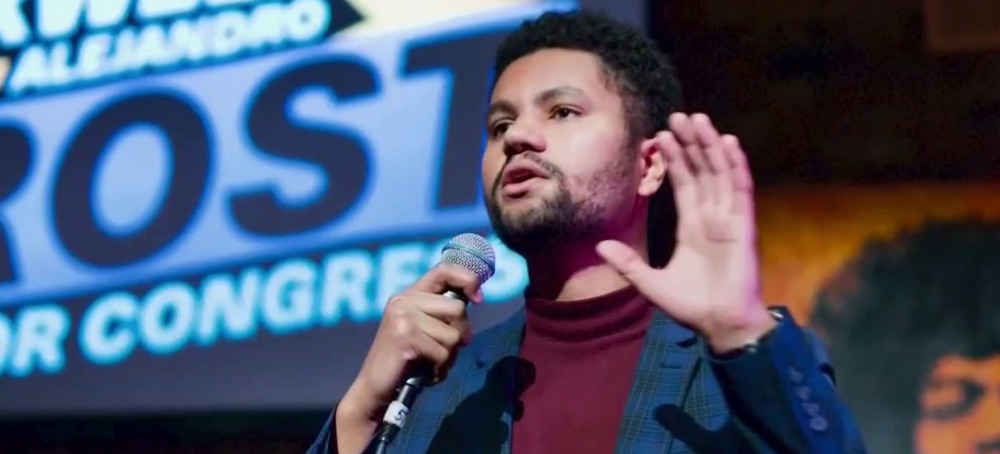 Maxwell Alejandro Frost on Tuesday clinched the Democratic nomination for Florida's 10th Congressional District. (photo: Frost for Congress)
Maxwell Alejandro Frost on Tuesday clinched the Democratic nomination for Florida's 10th Congressional District. (photo: Frost for Congress)
We go to Florida to speak with 25-year-old gun control activist Maxwell Alejandro Frost, who made history last week when he won the Democratic primary for an open U.S. House seat in Orlando. Frost is set to become the first Afro-Cuban and first member of Generation Z elected to Congress if he goes on to win November’s general election for Florida’s heavily Democratic 10th Congressional District. Frost discusses his decade as a movement organizer in Florida and breaks down his stance on Palestine, Cuba and how to reach Trump supporters in Florida.
Maxwell Alejandro Frost, welcome to Democracy Now! Can you talk about why you feel this victory, which could well be a victory in November, is so important for this country?
MAXWELL ALEJANDRO FROST: Well, thank you so much for having me on. I think this is important for this country because it sends a message to not just young people, but all folks, to not count young people out of the conversation, and the fact that in a democracy, in a representative one, we need a Congress and a government that looks like the country. And yes, that means in terms of our race, but it also means in terms of age and experience and where people come from.
JUAN GONZÁLEZ: And I’d like to ask you — in terms of your activism, you’re very young, but you’e already had about a decade of experience in grassroots campaigns. Could you talk about some of the campaigns that you’ve been involved in and how that propelled you to want to run for Congress at such a young age?
MAXWELL ALEJANDRO FROST: Yeah. Well, for me, this journey started 10 years ago because of the Sandy Hook shooting. I remember seeing what happened on the television screen. It actually really pushed me to go to the vigil that was going on in Washington, D.C., where I met one of the brothers of one of the victims. And the experience I had with him just changed my life forever. And I left that experience saying that for the rest of my life, I’m going to fight for a world where no one has to feel the pain I saw him feel that night.
Since then, I’ve been working in politics and in the movement world in movements that I feel like will bring justice to folks. And so, when we talk about Amendment 4, I worked for the ACLU, leading their field effort here in Florida, knocking doors, making phone calls, working to win the hearts and minds of folks, to say, “Hey, look, people deserve second chances. People deserve to vote once they get out of prison, and, you know, people with previous felonies.” And so, I had the honor of being a part of that struggle, too. At March for Our Lives, I became the national organizing director, where I worked hand in hand with young people from all across the country, over 200 chapters, training, educating and resourcing them to have what they need to make a difference in their local government, and whether or not that’s working to get more money for community violence intervention, so communities can stop violence before it happens, or fighting for safer gun laws. And so, you know, I’ve had the privilege of being a part of some very important struggles in our country’s history over the past decade and want to take what I learned there as a movement organizer and bring it to Congress.
AMY GOODMAN: I wanted to ask you about your views on Israel and Palestine. A few weeks ago, you published a position paper in which you said U.S. military aid to Israel is, quote, “one of the most important parts of the foreign aid that we contribute to.” You also said the boycott, sanctions, divestment movement — the Boycott, Divestment, Sanctions movement, or BDS, is “extremely problematic and undermines the chances of peace.”
Many Palestinian Americans in your district said they felt deceieved and betrayed by your views, after supporting your run. I think it was Rasha Mubarak who told the Middle East Eye, “Essentially, he built his campaign off our pain and our hope to elect another voice into Congress who advocated for a free Palestine.”
And I also wanted to ask you about that issue of money in the campaign. The Israeli newspaper Haaretz reports position “did not provoke enough opposition for super PAC spending.” You received a million-dollar pledge of support from the new super PAC, Protect Our Future, funded almost entirely by the crypto-billionaire Samuel Bankman-Fried. Can you talk about that?
MAXWELL ALEJANDRO FROST: Yeah, for sure. Well, you know, for myself as an organizer, as a progressive, I mean, when I close my eyes and I think about the world that I want to live in, it’s a world where Palestinians are able to live free, have the resources they need and just be able to live their lives, you know, very, very similar to what I believe Americans should have, as well. And same thing with Israelis. I close my eyes and think of a world where Israelis are able to live in a world free of violence and without the fear of being gunned down or any missiles or anything like that.
And so, I support a two-state solution, because I believe that’s the strongest and quickest path towards peace for the entire region. And all subsequent policy for me has to point to that two-state solution, ensuring that Palestinians have their own sovereign state where they’re able to live. And I think there’s things that Israel needs to do in ensuring that the mass demolitions, evictions stop, that the settlement expansions stop, so we can move towards peace. And then, you know, Hamas needs to stop lobbing missiles towards Israel. It’s putting families and children at risk, as well. And I think when we get to a place where peace is possible, a two-state solution is the best way forward. And that’s what I champion, and that’s what I’m going to push for in Congress.
JUAN GONZÁLEZ: And, Maxwell, you live in Central Florida. How do you speak to the Trump supporters, especially the conspiracy theorists and election deniers? Do you think there’s a way to win them over, or do you just have to mobilize a bigger vote from people who don’t hold their views?
MAXWELL ALEJANDRO FROST: You know, I think it’s becoming increasingly difficult, but it is important. I mean, we can never give up on anybody. As an organizer myself, I really believe that this has to be about the battle for hearts and minds. And that means never giving up on people, no matter how far gone they might seem. Again, it’s becoming increasingly difficult, especially with the rhetoric we’re hearing from the right, what we’re hearing from those leaders, but we can never give up on the flight of just talking to our fellow human beings about what we believe in and why we believe in this future.
And at the end of the day, the message that we carried in this primary, part of the reason we won and why we’re going to win this general in November, is that it’s a platform all about love. And that’s something that anyone can get behind. It’s bringing together common, shared values behind an agenda that means: Because I love you, I want you to have healthcare, I want you to have safety, and I want you to have the opportunity that you deserve.
JUAN GONZÁLEZ: And I wanted to ask you — your family, your adopted parents, your mother was from — the grandmother was from Cuba. And I’m wondering your perspective, given the importance of Cuban relations with the electorate in Florida, how you feel about the Biden administration’s current stance and policy toward the nation of Cuba.
MAXWELL ALEJANDRO FROST: Yeah, I mean, the way I approach Cuba — and a lot of times it’s me just thinking about my family there, me thinking about the most vulnerable people there. I believe that there are multiple truths to be had. You know, the current regime in Cuba is oppressive to the Cuban people, has been. That is why my grandma, my abuela, my mom, my aunt, they came here during the freedom flights in the late 1960s to escape that and find a better life. But at the same time, also recognizing that U.S. and Cuba policy that’s been normalized hasn’t been working, in fact, and a lot of times has been affecting the most vulnerable people and not the folks we need to affect to create the policy change that’s needed on the island. So, you know, there’s multiple truths that need to be held there. I think it’s important to normalize those relations and move to a place where we are centering the poor and working-class families in Cuba that are crying out for help and support from a violent, oppressive regime.
AMY GOODMAN: Maxwell Frost, are you for lifting the embargo?
MAXWELL ALEJANDRO FROST: I am.
AMY GOODMAN: Finally, President Biden is going to Pennsylvania today, calling for an assault weapons ban. You’re a major anti-gun activist. Do you feel that this is enough?
MAXWELL ALEJANDRO FROST: I’m sorry. Can you repeat it, the question?
AMY GOODMAN: Oh, President Biden is going to Pennsylvania today, calling for an assault weapons ban.
MAXWELL ALEJANDRO FROST: I think an assault weapons ban is extremely important. I think the bipartisan bill that was passed just a few months ago is also important in taking the steps necessary to end gun violence in this country. And what we know is the leading cause of death for children recently went from automobile accidents to gun violence. And so our children are literally on the frontlines of this. There’s a lot more that needs to be done, but I think these steps are important and significant, especially when you don’t allow yourself to get clouded with the statistics and the numbers. Behind every number, there’s a human, there’s a person, there’s a family, there’s a story. And when we learn that, legislation that can save one, two, three, four, five lives a day is more than worth it. There’s a lot more work that needs to be done, but I think these are important steps.
AMY GOODMAN: Maxwell Alejandro Frost, we want to thank you for being with us, won the Democratic primary, first Generation Z’er. I’m Amy Goodman, with Juan González.
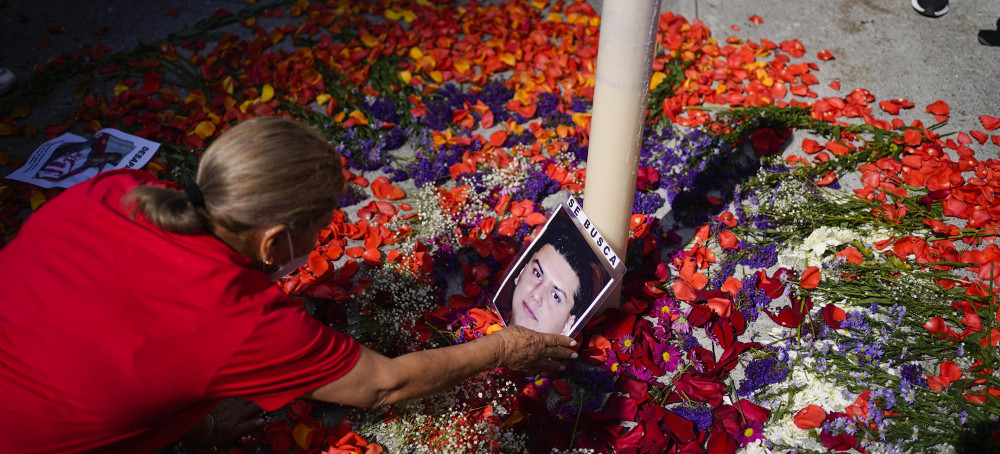 A person places a photo of a missing loved one on an improvised altar at La Palma roundabout on The International Day of the Disappeared during a march along the Paseo de la Reforma street by families who want the government help locate their missing relatives in Mexico City, Tuesday, Aug. 30, 2022. (photo: Eduardo Verdugo/AP)
A person places a photo of a missing loved one on an improvised altar at La Palma roundabout on The International Day of the Disappeared during a march along the Paseo de la Reforma street by families who want the government help locate their missing relatives in Mexico City, Tuesday, Aug. 30, 2022. (photo: Eduardo Verdugo/AP)
The protesters carried photos of the disappeared hanging from their necks, and chanted “Where are they? Our Children, Where are they?”
Many claimed that, rather than investigating the abductions, authorities are quick to assume that disappeared people might have been involved in illicit activities.
”Frequently, there are no investigations, re-victimizations. We continually face negligence and inaction,” said Miriam Jaqueline Palmeros, whose daughter Jael Monserrat Uribe disappeared two years ago and has never been seen since.
To mark the International Day of the Disappeared, family members mounted a panorama of photos of the missing, and performed prayers, rituals and songs for them. Most of the disappearances began after the start of Mexico’s drug war in 2006.
While abductions and disappearances sometimes involve street-level drug dealers picked up by rival gangs, the disappeared also include kidnap victims, passing motorists caught at drug cartel checkpoints and witnesses to crimes or passersby.
Guillermo Fernández Maldonado, the Mexico representative for the U.N. Office on Human Rights, noted “these are really enormous numbers.”
“These are not like some situations that are in the past,” Fernández Maldonado said. “These are serious situations that continue to happen every day.”
The protesters demanded that authorities start searching earlier, within the first few hours after a disappearance, rather than waiting — as they often do — to see if a missing person shows up on their own.
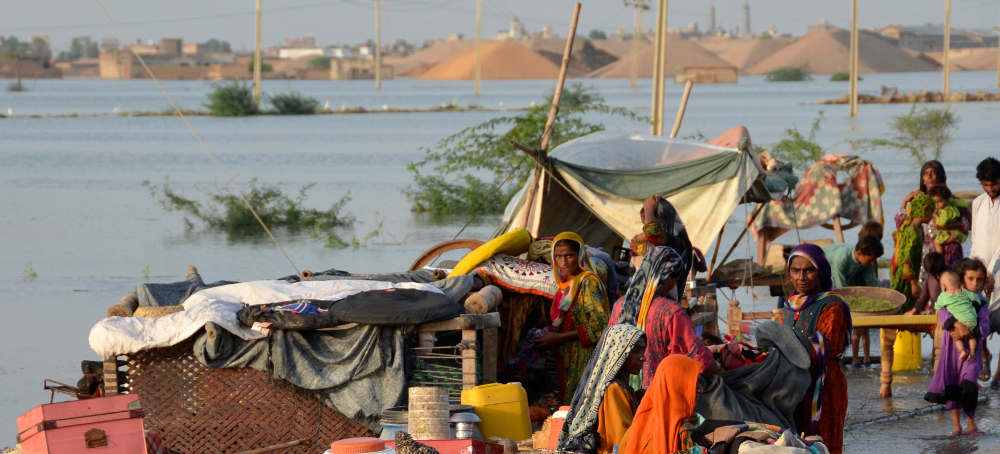 Nearly a million homes have been destroyed or badly damaged by flood in Pakistan. (photo: Zahid Hussain/AP)
Nearly a million homes have been destroyed or badly damaged by flood in Pakistan. (photo: Zahid Hussain/AP)
ALSO SEE: Millions in Need of Aid as
‘Unprecedented’ Floods Hit Pakistan
Pakistan has more than 7,000 glaciers. Climate change is melting them into floodwater.
A series of extreme floods has utterly devastated the South Asian nation, which is home to some 225 million people, washing away roads and buildings, destroying farms, and stranding hundreds of thousands. Over the weekend, which brought another bout of torrential rain, government officials said the death toll had soared past 1,000 and water had inundated as much as a third of the country.
The main fuel for these catastrophic floods is rainfall. Summer is monsoon season, and this has been a particularly wet and wicked one, perhaps made worse by climate change.
But there’s another culprit behind the recent devastation: melting glaciers and snow.
Pakistan is home to over 7,200 glaciers, more than anywhere outside the poles. Rising temperatures, linked to climate change, are likely making many of them melt faster and earlier, adding water to rivers and streams that are already swollen by rainfall.
“We have the largest number of glaciers outside the polar region, and this affects us,” Pakistan’s climate minister Sherry Rehman told the Associated Press. “Instead of keeping their majesty and preserving them for posterity and nature,” she said, “we are seeing them melt.”
That means that Pakistan — already one of the countries most vulnerable to climate change — will become increasingly susceptible to flooding as the planet warms. It’s an unfortunate reality for a country responsible for just a tiny fraction of global greenhouse gas emissions, underscoring how the harm caused by big polluters is often exported. Like many countries, Pakistan will bear an unequal burden of climate change in the years to come.
Melting ice and snow worsens floods
Glaciers are dense masses of compressed ice found in mountains all over the world, from the Alaska Range to the French Alps. It’s normal for them to shrink and grow within a single year — they melt in the summer and expand in the winter.
But on the whole, glaciers have grown smaller over the past several decades because they’ve been unable to regain their mass in the winter. One simple reason is that heat melts ice and the planet is warming up. Higher temperatures can also turn snow into rain, and when rain falls on ice, it further accelerates melting, according to Ulrich Kamp, a professor at the University of Michigan Dearborn who’s been studying glaciers for roughly 20 years.
This is a big problem in Pakistan. The country is not only a glacier hot spot, but melting in the Himalayas — one of the main mountain ranges in the country — is accelerating, according to a 2021 study.
“Our findings clearly show that ice is now being lost from Himalayan glaciers at a rate that is at least ten times higher than the average rate over past centuries,” Jonathan Carrivick, the study’s lead author, said in a statement when the study came out.
Along with melting snow, glacial runoff can cause rivers to swell, even many miles downstream from the mountains, Kamp said. That’s especially worrisome when it coincides with monsoons, which climate change may also be worsening (partly because hotter air can hold more water).
“With this increase of glacial meltwater for the next decades — because of climate change — we will have to deal with floods,” Kamp said.
Glacial melt can also cause alpine lakes to burst
There’s another way melting ice can cause extreme floods: In the mountains of Pakistan, water from glaciers forms high-elevation lakes, which are often dammed by glacial ice. When there’s too much runoff, those lakes quickly expand and the ice dams can break, producing what’s called a “glacial lake outburst.”
Those breaches are extremely dangerous. In April, one of the hottest months on record in Pakistan, a glacial lake near Mount Shishpar burst, likely because it ballooned too quickly with melted ice, as the Washington Post’s Kasha Patel reported. Water flooded a village in northern Pakistan and swept away a bridge.
Northern Pakistan now has more than 3,000 glacial lakes, and some of them appear to be forming earlier in the year due to severe heat. Alarmingly, 33 of them are “prone to hazardous glacial lake outburst flooding,” according to the United Nations.
This year, there have been more than a dozen glacial outbursts, well above the annual average of five or six. It’s not clear, however, to what degree those outbursts worsened the flooding in recent weeks.
Rich nations are largely responsible for the extreme effects of climate change
Scientists have yet to determine what role climate change plays in the floods, but it’s clear that warming puts Pakistan at risk. It’s not just the floods. It’s heat, drought, and other telltale symptoms of rising temperatures. Indeed, according to a global climate risk index developed by a German NGO, Pakistan is the eighth most vulnerable country to extreme weather.
Even if global warming is limited to 1.5 degrees Celsius, the more ambitious goal under the Paris climate agreement, a third of Pakistan’s glaciers could still melt. And as they shrink, they could near a tipping point, Kamp said. “Suddenly, when they are that small, everything turns around 180 degrees, from too much water and flooding to drought,” Kamp said.
To that end, Pakistan has called on rich nations to fulfill a pledge they made more than a decade ago to provide lower-income nations with $100 billion a year to adapt to climate change.
“Developing countries, whilst not responsible for the majority of emissions today, too often bear the brunt of climate change impacts,” Ambassador Aamir Khan, deputy permanent representative of Pakistan to the UN, said at a briefing in July. “The specific challenges faced by the developing countries in climate change must be recognized.”
Follow us on facebook and twitter!
PO Box 2043 / Citrus Heights, CA 95611

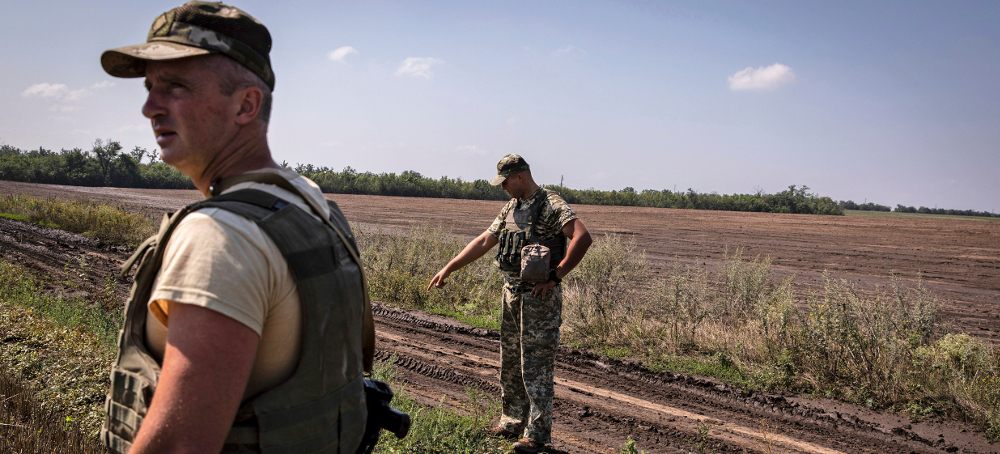
Comments
Post a Comment